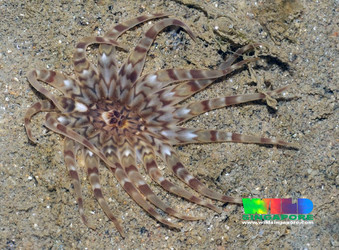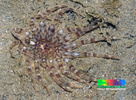Haloclavidae
Characteristics
Body elongate, aboral end physa-like or forming a physa sometimes broadly adherent in Mesacmaea. Column either smooth or with hollow or solid papillae or suckers rarely with cinclides, rarely divisible into physa, scapus and scapulus. No sphincter or rarely a weak or moderately developed diffuse one (in Mesacmaea and Oractis). Tentacles short, sometimes capitate, usually simple, never numerous, the inner shorter or of same length as the outer ones. A single, ventral, usually very strong siphonoglyph, which is occasionally more or less completely separated from the other part of the actinopharynx, and sometimes drawn out at its oral end into a more or less folded conchula. Perfect pairs of mesenteries varying in number, usually they are all macrocnemes, in Oractis only 8 mesenteries are perfect. Retractors usually strong.References
Carlgren, O. 1949. A Survey of the Ptychodactiaria, Corallimorpharia and Actiniaria. Kungl. Svenska Vetenskapsakadamiens Handlingar, series 4, volume 1, number 1.
Title Illustrations

| Scientific Name | Peachia sp. |
|---|---|
| Location | Singapore |
| Specimen Condition | Live Specimen |
| Source | Peachia anemone |
| Source Collection | Flickr |
| Image Use |
 This media file is licensed under the Creative Commons Attribution-NonCommercial-NoDerivs License - Version 2.0. This media file is licensed under the Creative Commons Attribution-NonCommercial-NoDerivs License - Version 2.0.
|
| Copyright | © 2008 Ria Tan |
About This Page
The information provided on this page is based on Oscar Carlgren's 1949 catalog.Copyright © 1949 Swedish Academy of Sciences.
Please note that Carlgren's text contains a number of errors, and much of the information is now out of date. An update of the catalog is currently under preparation in Daphne Fautin's laboratory, and the results of this work will be incorporated in future versions of this page.
Keyboarding of Carlgren's catalog was done as part of a project to create an electronic database of the sea anemones of the world, funded by NSF Grant DEB9521819, awarded to Daphne G. Fautin. This grant is in the program Partnerships to Enhance Expertise in Taxonomy (PEET). Susanne Hauswaldt, Katherine Pearson, and April Wakefield-Pagels contributed to the keyboarding effort.
Correspondence regarding this page should be directed to Daphne G. Fautin at
fautin@ku.edu
Page copyright © 2000
All Rights Reserved.
Citing this page:
Tree of Life Web Project. 2000. Haloclavidae. Version 01 January 2000 (temporary). http://tolweb.org/Haloclavidae/17712/2000.01.01 in The Tree of Life Web Project, http://tolweb.org/








 Go to quick links
Go to quick search
Go to navigation for this section of the ToL site
Go to detailed links for the ToL site
Go to quick links
Go to quick search
Go to navigation for this section of the ToL site
Go to detailed links for the ToL site